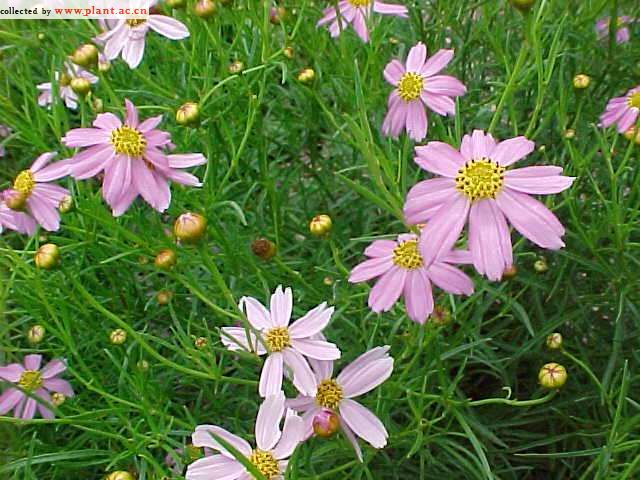Coreopsis roseaCoreopsis
Family:Asteraceae
属:金鸡菊属
common name:Coreopsis
introduce:Plant Type: Herbaceous perennial
Family: Asteraceae
Missouri Native: No
Native Range: Nova Scotia to Maryland
Height: 1 to 2 feet
Spread: 1.5 to 2.5 feet
Bloom Time: June - September
Bloom Color: Pink rays with yellow disks
Sun: Full sun (only)
Water: Medium moisture
Maintenance: Low
General Culture:
Easily grown in medium wet, well-drained soil in full sun. Unlike other species of Coreopsis, C. rosea and its cultivars have very little drought tolerance and need consistently moist soils in order to thrive. Avoid poorly-drained heavy clay soils, however. Prompt deadheading of spent flower stalks can be tedious for a large planting, but does tend to encourage additional bloom and prevent any unwanted self-seeding. Plants may be sheared in late summer to promote a fall rebloom and to tidy the planting (stems often become matted as summer progresses). In optimum growing conditions, plants will spread in the garden by rhizomes and self-seeding to form a dense ground cover, sometimes to the point of being considered invasive.
Noteworthy Characteristics:
Coreopsis rosea (sometimes commonly called pink coreopsis or pink threadleaf coreopsis) is primarily native to wet sandy soils along water margins in coastal plain areas from Nova Scotia to Maryland. It is noted for being the only coreopsis with pink flowers. It closely resembles C. verticillata in appearance and habit, but lacks the latters heat and drought tolerance. It is a rhizomatous perennial which typically grows in dense, bushy clumps to 1-2 tall. Features daisy-like flowers (1/2 to 1" diameter) with pink untoothed rays and yellow center disks. Flowers appear singly on short stalks in a profuse and lengthy summer bloom. Whorls of linear, grass-like, light green leaves lend a fine-textured and airy appearance to the plant. Plants in the genus Coreopsis are sometimes commonly called tickseed in reference to the resemblance of the seeds to ticks.
Problems:
No serious insect or disease problems. Can be an invasive spreader. Performs best in cool summer climates, and can appear rather scraggly with poor flowering in the hot and humid summer conditions of the deep South. Weak plant stems tend to sprawl and mat, particularly in hot and humid climates with periodic heavy summer rainfall.
Uses:
Long summer bloom and airy foliage provide good accent in borders or rock gardens. Good small area ground cover. Also effective as an edger for borders, foundations and walks/paths. Naturalized areas, native plant gardens or cottage gardens.
